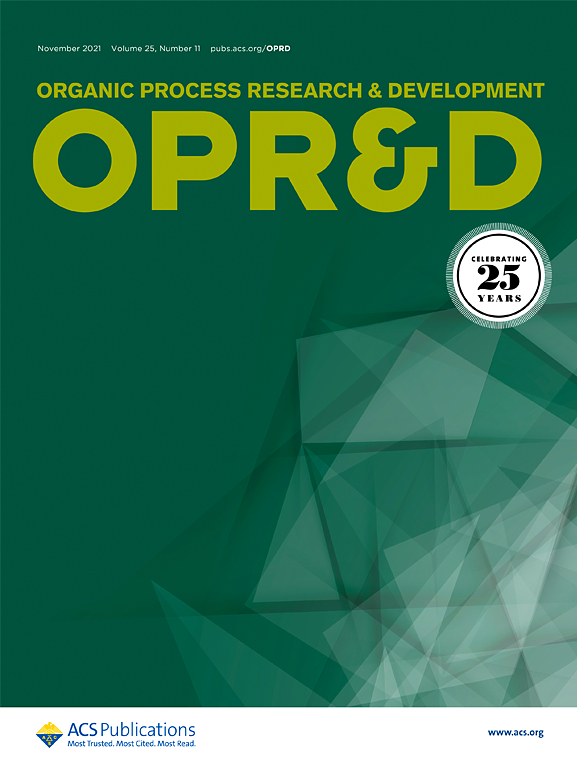光化学氧化催化合成螺旋烯─间歇反应器与流动反应器之比较
IF 3.5
3区 化学
Q2 CHEMISTRY, APPLIED
引用次数: 0
摘要
螺旋烯是一类具有螺旋手性的芳香分子,由于其轴向手性而被功能化,并在各种应用中引起了人们的兴趣。然而,它们的合成通常在高稀释条件下进行,以防止不良的副反应,并且需要大量的溶剂,这使得扩大规模成为一个挑战。本研究讨论了缩放螺旋烯合成的挑战,并提供了解决这些挑战的简单策略。随着人们对螺旋烯在材料、传感和电子应用中的应用兴趣的增加,需要开发出以高纯度有效缩放螺旋烯的策略。众所周知,流动化学为化学合成提供了更具可重复性、可扩展性、安全性和效率的选择,使其成为学术和工业环境中有价值的工具,因为它可以精确控制化学计量、混合、温度和反应时间等反应条件,从而为各种反应类别带来更高的产量和更好的选择性。利用定量1H-NMR和期望产物和重要副产物的分离产率,我们评估了三种反应器系统:1L-batch, 5L-batch和flow反应器,用于合成[5]-螺旋四酯(5HLTE)。在初始优化之后,使用最优条件来证明可扩展性,并在5ml反应器流量系统中提供了~ 5 g/天的吞吐量,与反应器体积呈线性缩放。纯度的离散控制对于这些应用至关重要,因为当应用于有机电子和聚合物机械性能时,杂质可能会提供不正确的结构-性能结论。本文章由计算机程序翻译,如有差异,请以英文原文为准。

Scaling Helicene Synthesis via Photochemical Oxidation─A Comparison between Batch and Flow Reactors
Helicenes are a class of helically chiral, aromatic molecules that are often functionalized and are of interest for a variety of applications due to their axial chirality. However, their syntheses are typically conducted under high dilution conditions to prevent undesirable side reactions and require large volumes of solvent, which makes scaling up a challenge. This study discusses the challenges of scaling helicene syntheses and offers facile strategies to address some of these challenges. The increased interest for using helicenes to address materials, sensing, and electronic applications necessitates that strategies for scaling them effectively with high purity need to be developed. It is well-known that flow chemistry facilitates more reproducible, scalable, safe, and efficient options for chemical synthesis, making it a valuable tool in both academic and industrial settings, as it allows for precise control over reaction conditions such as stoichiometry, mixing, temperature, and reaction time, leading to greater yields and better selectivity for a variety of reaction classes. Using quantitative 1H-NMR and isolated yields of the desired product and notable side products, we evaluated three reactor systems: 1L-batch, 5L-batch, and flow reactors towards the synthesis of a [5]-helicene tetraester (5HLTE). After initial optimization, the optimal conditions were used to demonstrate the scalability and provided throughput of ∼5 g/day in a 5 mL reactor flow system, scaling linearly with reactor volume. Discrete control of purity is vital for these applications in that impurities may provide incorrect structure–property conclusions when applied to organic electronics and polymer mechanical properties.
求助全文
通过发布文献求助,成功后即可免费获取论文全文。
去求助
来源期刊
CiteScore
6.90
自引率
14.70%
发文量
251
审稿时长
2 months
期刊介绍:
The journal Organic Process Research & Development serves as a communication tool between industrial chemists and chemists working in universities and research institutes. As such, it reports original work from the broad field of industrial process chemistry but also presents academic results that are relevant, or potentially relevant, to industrial applications. Process chemistry is the science that enables the safe, environmentally benign and ultimately economical manufacturing of organic compounds that are required in larger amounts to help address the needs of society. Consequently, the Journal encompasses every aspect of organic chemistry, including all aspects of catalysis, synthetic methodology development and synthetic strategy exploration, but also includes aspects from analytical and solid-state chemistry and chemical engineering, such as work-up tools,process safety, or flow-chemistry. The goal of development and optimization of chemical reactions and processes is their transfer to a larger scale; original work describing such studies and the actual implementation on scale is highly relevant to the journal. However, studies on new developments from either industry, research institutes or academia that have not yet been demonstrated on scale, but where an industrial utility can be expected and where the study has addressed important prerequisites for a scale-up and has given confidence into the reliability and practicality of the chemistry, also serve the mission of OPR&D as a communication tool between the different contributors to the field.

 求助内容:
求助内容: 应助结果提醒方式:
应助结果提醒方式:


